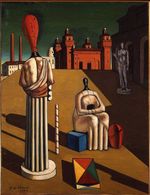 Sue Hubbard
Sue Hubbard
It was the week after Easter in Rome and the sun was out. The Spanish steps were heaving with tourists and ice cream sellers. Algerian immigrants hawked cheap leather goods. For most the steps simply provided a place to rest; as one ample lady from Texas put it: “ok, so I’ve seen them now, is that it?” Clearly she wasn’t impressed. Relaxing with their maps and bottles of water wondering what to do next few seemed to realise that just yards away from where they were sitting the 26 year old Keats had died a horrible death from tuberculosis (the wonderful museum was practically empty when we visited) let alone that one of the 20th century’s most puzzling artists, Giorgio de Chirico had lived over the road.
The Giorgio and Isa de Chirico Foundation was founded in 1986 by Isabella Far de Chirico, the painter’s widow, who in 1987 donated 24 of her husband’s works to the Italian state.Upon her death, in November 1990, the Foundation inherited the painter's apartment in the Piazza di Spagna – the 17thcentury Palazzetto dei Borgognoni – where he had lived and worked until his death in 1978. In November 1998 it opened as a museum filled with his late paintings, drawings, sculpture and lithographs, along with manuscripts and photographs.
It is a strange place,a haven of quiet above the crowded street below. I had expected something rather more bohemian from this ‘metaphysical’ painter, but found, instead, an airy bourgeois apartment full of antique furniture, comfortable sofas and rugs. Not what I had predicted from this one time friend of Apollinaire, Picasso, and that arch surrealist André Breton, who had hailed de Chirico’s early dream-like cityscapes as pivotal within the development of Surrealism. Most odd was the tiny monk-like bedroom, Spartan in its decor except for a few books, with its narrow childlike bed under a white cover, where the ‘maestro’ slept across the hall from his Polish second wife, the intellectually and emotionally powerful, Isabella Pakszxwer, whose rather large double bed sported a flamboyant red counterpane.
The enthusiastically hailed period – the pittura metafisica – on which de Chirico’s reputation is based, lasted until around 1918. Then his work changed. Why? The official version is that he was paying homage to the Old Masters of the Renaissance, pitting himself against the greats of art history by going to Florence and studying techniques of tempera and panel painting. As Robert Hughes wrote rather pithily, “he imaged himself to be the heir of Titian”.[1] Denounced by the French avant-garde de Chirico counter-attacked with diatribes on modernist degeneracy signing his work Pictor Optimus (the best painter.) But why should an artist who had written: “It is necessary to discover the demon in all things….to discover the eye in all things – We are explorers ready for new departures,” turn his back on contemporary aesthetic discourses in favour of producing second rate paintings that would not, if it weren’t for the significance of his early work, get a look in within the annals of art history?
Read more »
When we meet to discuss his work we have to decamp from the pub in Camberwell, which is both Mat Collishaw’s studio and stylish home, to a local café, as his apartment has been let out to a well known London store for a shoot and is full of rampaging children. But before we leave he shows me his new paintings. At first glance they appear to be abstract, constructed on a modernist grid, though the lines, in fact, are folds, creases left in the small square wraps of paper used to sell cocaine. These wraps have been torn from glossy magazines; there’s a woman’s foot in a high-heeled shoe resting on a glass table, and adverts for Fendi and Gucci. The subtext seems to be that these aspirational trappings are the spectral presence of an endless illusion that functions much like an addiction to drugs. You’re always left wanting more. The work is about debasement; the debasement of modernist painting as a form and as a result of the recent financial excesses that have led to the current economic crisis. This tension between the beautiful and the abject, between the promise of a possible paradise and the profane is central to all Mat Collishaw’s work. As the Marquis de Sade once said: “There is no better way to know death than to link it with some licentious image”.
